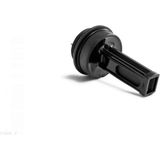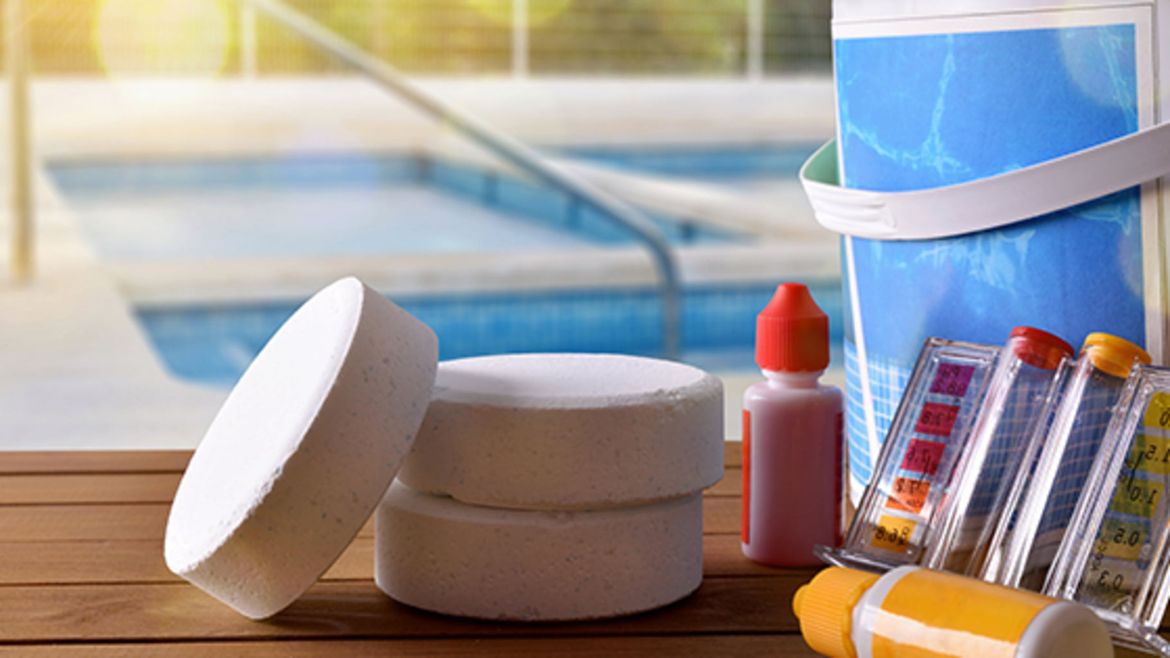Cyanuric acid and chlorine stabiliser: When chlorine is (not) working as it should
What is cyanuric acid?
We'd like to keep this guide as simple as possible which is why we are not going to explain the underlying chemistry 100% accurately but will present a greatly simplified version of it. This will however not be a disadvantage in understanding pool water care or achieving optimal results.
Cyanuric acid (closely related to isocyanuric acid and with the same effect) is a substance that
- is used to produce organic chlorine
- can be added manually and separately to pool water
What is organic chlorine?
Our range of pool chemicals features almost exclusively organic chlorine products. In contrast to inorganic chlorine, organic chlorine is easier to use by beginners and often by advanced users as well. First off, because it is pH-neutral, it does not result in limescale and secondly, the chlorination process is more stable and reliable. One of the defining features of organic chlorine is that it always contains cyanuric acid.
How does cyanuric acid work?
Depending on the amount of cyanuric acid in the pool water, the effect can be positive or negative. In general though, if the amount is not too high, the effects are positive and very desirable.
Stabiliser
Cyanuric acid combines with chlorine and prevents chlorine from acting immediately and being used up quickly. This ensures that the chlorine works evenly over a longer period of time. Instead of being quick and intense, the chlorine is allowed to work more gently and slowly. This is why cyanuric acid is also called a chlorine stabiliser. A product like Steinbach's chlorine stabiliser, for example, contains cyanuric acid.
UV protection
The second, less well-known effect is that cyanuric acid protects chlorine from breaking down when exposed to high amounts of UV radiation. Pool water is exposed to very high UV radiation on hot summer days when the sun is high in the sky. UV rays decompose effective chlorine and it is lost without having performed its task as a disinfectant. Usually, this effect takes place in the upper layers of water near the surface and can reach depths of up to 1 m. However, chlorine particles that are bound to cyanuric acid do not decompose. They have a delayed effect. For example, late in the afternoon when UV radiation is much lower or completely absent.
Too much chlorine stabiliser is not good!
It is extremely important to bear in mind that chlorine does not disinfect while bound to cyanuric acid. The aim should be to buffer only about 20-40% of the chlorine. Any higher and the disinfecting effect of chlorine will suffer.
The correct way to use a chlorine stabiliser (= cyanuric acid)
The most important properties:
- if there is too little chlorine stabiliser or cyanuric acid, the disinfection is too uneven and fast
- if there is too much chlorine stabiliser, the disinfection performance is greatly reduced
- if the amount of chlorine stabiliser is too high, the only way to ensure effective disinfection is by adding more chlorine
- cyanuric acid does not break down on its own!
There are two scenarios we should consider:
- Using chlorine tablets or Multitabs and the resulting accumulation of cyanuric acid over time
- Manually adding chlorine stabiliser to inorganic chlorine (for example: calcium hypochlorite or saltwater systems with sodium hypochlorite) Let's look at that separately.
Case 1: regular use of chlorine tablets
This tends to be the case with most home users who own pools such as frame pools, inflatable pools, or steel wall pools. How can you tell if you are using organic chlorine?
- The packaging contains terms such as "ph-neutral" or "pH stabiliser". Only organic chlorine does not affect the pH value of water.
- Troclosene sodium, symclosene, trichloroisocyanuric acid - one of these terms is specified as the active ingredient in the product data sheet.
If either of these is true, the active chlorine, i.e. the free chlorine, you are using is organic in nature. When this is used, cyanuric acid is always released into the water. Note that most granulated chlorine products also contain cyanuric acid - such as the product by Pool Professional or Steinbach's chlorine granulate.
Build-up of cyanuric acid in the pool
The good news first: Even if chlorine stabiliser is being constantly added to your pool water, the amounts added are generally still acceptable with the normal use of chlorine tablets over the duration of a season. However, excessive chlorination or one or more shock chlorination processes can result in the accumulation of too much cyanuric acid towards the end of the season. This may result in the worst-case scenario where your pool water turns green although the pH value of your water is right and there is a sufficient amount of free chlorine. How do you fix this? Measure cyanuric acid (abbreviated to "CYA") if you are unsure of the cyanuric acid content in your pool. Note that many water testers don't measure this value. But some products, such as the pool tester by Poollab, do measure this value. The CYA value is given in "parts per million" and a value in the range of 8-15 ppm is optimal - you should be careful not to let it go beyond that. Even a value of 25 and up to a maximum of 30 is OK if you keep up a good pool water care routine. But if the value is over 30, we strongly recommend that you lower it. We'll describe how you can do that below.
Case 2: Adding the right amount of chlorine stabiliser manually
If you use a saltwater system for your saltwater pool you should bear in mind that sodium hypochlorite is formed in the process - this is inorganic, free chlorine. Case 2 also applies when inorganic free chlorine is added manually. A chlorine stabiliser can be used in such situations. However, chlorination will not be very even and there will be no protective buffer against UV rays. This may be acceptable with inorganic chlorine tablets since tablets dissolve gradually and evenly over time, but that's not the case in a saltwater system.
Operating a saltwater system without cyanuric acid? Not a good idea
Saltwater systems usually run for one or more hours at a time every day. Multiple cycles are not possible with many chlorinators (at least not automated). The result is that increased amounts of disinfectant are present in the water for a short time which gets quickly used up due to the reaction with organic substances (microorganisms such as bacteria, algae, viruses, substances that cause water turbidity, etc.). Plus, exposure to strong sunlight (UV rays) causes additional break down of chlorine. This can mean that there is no free chlorine in your pool water over an extended period of time! The same is true if you're using a salt-electrolysis hot tub - only it's even worse, because the water temperature in a hot tub is typically at 30°C or higher.
The solution: Steinbach Chlorine Stabiliser
Steinbach offers Chlorine Stabiliser Granules (cyanuric acid) that can be added manually. Here are tips on how to use it:
- Add 10 g of Steinbach Chlorine Stabiliser for every cubic meter of pool water
- You can either weigh the correct amount of stabiliser or use the measuring scoop. 10 g correspond to 15 ml.
- We recommend that you dissolve the chlorine stabiliser separately in a bucket and then pour it into the pool with the filter system running.
A little background info - since it is difficult to remove cyanuric acid from pool water, it is better to add too little than too much. That's why we stay below the dosage recommended by Steinbach. You can always add more if you wish.
The dissolving process
Cyanuric acid added to pool water dissolves very slowly and not easily. If you're unlucky, the dissolving process can take several days. That's why we recommend that you dissolve chlorine stabiliser in a bucket of very warm water first. Even at high water temperatures, it does not dissolve easily - but it is much better than at 15°C or 25°C. We suggest that you fill up a bucket with 10 L of 50-70°C hot water and then add the required amount of Steinbach Chlorine Stabiliser. Stirring it well should be enough to dissolve most of it, which you can then add to your pool water. You may have to repeat this process several times until all the cyanuric acid is dissolved. Since cyanuric acid doesn't break down on its own, you will thankfully not need to repeat this process often. Depending on the circumstances, you might need to do it just once a year or just once over several years.
Cyanuric acid and measuring free chlorine: Not so trivial!
It is generally recommended to keep the free chlorine level in pool water between 0.3-0.6 mg per litre. However, if the cyanuric acid level in the water is 30 ppm, then only around 40% of the chlorine is available for disinfection. (plus: if the pH is 7.5 or above, that lowers the amount of free chlorine even further!) For instance, you measure 0.4 mg per litre of free chlorine and 30 ppm of cyanuric acid. With a very good pH value of 7.0, you can assume that the actual chlorine value is only 0.16! So either lower the cyanuric acid amount (but not too much - the buffering effect is desirable and intentional) or increase the amount of free chlorine.
Lower the CYA level in the pool
Sometimes you will hear comments such as "the pH level is 7.0 and chlorine at 0.5. Why is my pool still turning green?" In this case, if you were to ask about the CYA level, you would probably get an answer such as "the measured value is 70 ppm". That's way too high! This value needs to be reduced urgently! The problem is, CYA does not degrade on its own.
To reduce the CYA level, partially drain the pool and add fresh water.
Latest reviews
-
 5.0 (8)
5.0 (8)Intex Frame Pool Set Rondo Ø 366 x 122 cm without Filter System, 1 item - Model 2025
Bestseller- Extra strong and durable pool liner
- Integrated support structure for high stability
- Quick and easy to assemble and disassemble
£295.00Delivery by January 29
-
 £49.00
£49.00Delivery by January 29
-
Great Britain: Free standard delivery from £99.90
-
Free
returns -
We operate in a
climate-conscious manner. Secure payments
with SSL encryption technology


